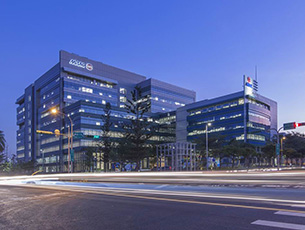Talent Attraction and Development
|
Global Employee Distribution |
|---|
MiTAC recognizes contributions from diverse talents, hence we strive to employ local people and those who are physically and mentally impaired as the first priority. With the capacity of the people in performing the required duties as the criteria for employment, we provide diverse job opportunities without discrimination against gender, religion, race, nationality or political affiliation. In 2024, we hired five indigenous workers and 16 employees with physical and intellectual disabilities in Taiwan Region while hiring 29 employees with physical and intellectual disabilities in mainland China. In addition, the employment policy of MiTAC explicitly states that all applicants and employees be fairly treated in recruitment, employment, development, evaluation, reward and remuneration. In 2024, due to increased production demand, the number of employees at all major production sites increased.







|
Talent Cultivation and Development |
|---|
Diverse Learning Resources for the Creation of Environments Suitable for Talents
Starting from when employees join MiTAC, we are committed to providing training programs to new hires, professionals, and managers that integrate employee career growth with Company development plans. We offer diverse learning resources, including online learning, on-the-job training (OJT), study groups, professional external training, and subsidies for continuing education. Through self-directed learning and team learning activities, we foster continuous development among employees. We are dedicated to creating a conducive environment for talent cultivation, fostering employee capabilities, and building communication bridges to allow each employee to leverage their strengths, work with peace of mind, engage long-term, and jointly cultivate and develop at MiTAC. In 2024, the total training hours for employees reached 387,237.1, with an average training hours per person of 56.1 hours. The total training cost for the year amounted to NT$8,943,909, with an average training cost per person of NT$1,295.8.
Comprehensive New Employee Orientation Training for Organizational Integration
MiTAC is committed to welcoming each new member by providing orientation training and comprehensive new employee orientation courses. The content includes the Company's philosophy, organizational background, labor safety and information security promotion, as well as HR regulations and employee benefits information. Department heads are responsible for job guidance, while life counselors are arranged to assist new employees in adapting to the team and environment. Through various arrangements, we assist new employees in quickly familiarizing themselves, adapting, and integrating into Company operations.
Strengthening Management Competency for Improvement of Training and Leadership
Continuing last year's management competency development program, we enhanced the learning outcome transformation mechanism to nudge participants to transition from Coachee to Coach. Through a teaching-while-learning-from-each-other model, we aim to help them internalize what they have learned and enhance their training skills, while expanding career development and organizational learning culture. In 2024, our development plan further emphasized application and practice. Through Individual Development Plan (IDP), we aligned development goals and integrated competency development with work, including expanding the practice of coaching-style leadership, establishing an internal coaching cultivation mechanism for participants to mentor new participants, and encouraging the use of coaching techniques in daily management to ensure effective implementation of what has been learned. Through external consultants and employee feedback mechanisms, managers can review their leadership styles from different perspectives. After the conclusion of the project, the self-assessment result showed a mindset/behavior change of 8.46 points; thus, this helped managers be aware and continuously improve. Over two years, 33 excellent participants completed the project, with a project satisfaction of 9.35 points. Moving forward, we will continue to cultivate high-impact management talent, to ensure that managers possess the ability to adapt to change and lead teams, thus promoting sustainable organizational development.

Encouraging Diverse Learning to Promote Career Development
To empower employees in planning their future careers, MiTAC conducts semiannual two-way discussions between managers and employees to develop employee career development plans. Unit managers are responsible for providing technical skills training while implementing a rotation system to encourage multi-functional development, cultivate expertise, and enhance corporate competitiveness. We also encourages employees to participate in master's in-service programs and EMBA programs to continuously enhance their professional and management abilities.
Promoting "MiTAC Loves Learning" to establish an organizational learning culture (Taiwan)
To enhance overall learning motivation, we offer diverse online courses, covering industry trends, online book reading, and planning and organizational skills. We also launched "MiTAC Loves Learning" to strengthen the penetration of learning culture. To ensure learning effectiveness, we provide flexible learning resources and designed learning progress tracking and incentive mechanisms, to encourage participants to interact and increase their learning motivation. Through this program, the course completion rate for participating employees reached 88%, demonstrating the significant effectiveness of learning promotion. We will continue to optimize course content, enhance user experience, and promote knowledge sharing through internal learning communities, to ensure that employees can flexibly use online and offline learning resources, thus fostering individual and organizational growth and building a continuous learning corporate culture.
Vietnamese Language Training (MSL, Mainland China)
|
To support the Group's strategy for establishing a plant in Vietnam, MSL meticulously organized two sessions of Vietnamese language training in 2024. The course content was designed to be closely related to actual work scenarios, with production processes incorporated into the course, thereby improving practical application effectiveness. We adopted an interactive teaching approach for the course, to increase interactive dialogues and promote work scenario exercises to help employees quickly master basic Vietnamese communication skills. This allowed participants to gain a deeper understanding of the local culture while learning the language, thus effectively raising employees' willingness to be expatriated abroad and providing strong support for talent development at the Vietnam Plant. |
|
MiReading Book Club (MSL, Mainland China)
|
|
MSL held its third MiReading Book Club in April 2024, focusing on learning the eight core competencies as monthly reading themes. Mutual exchange and sharing of reading reflections promoted growth among all book club members, thereby enhancing their competencies. At the same time, collaborative reading and sharing fostered a deeper understanding of competencies, and the small group of book club members influenced more colleagues to continuously learn. A team points mechanism was established in this book club session, thus fostering healthy competition, proactive learning, connections among employees, and mutual trust and a sense of belonging. |
MiTAC Living Wage Commitment
We believe that “family wage” is an important item that should be taken into consideration for improving the condition of workers’ lives. When discussing remuneration policies, we not only comply with local laws and provisions, but also pay continuous attention to local family and minimum wages. Furthermore, we participate in wage surveys conducted by our peers on a regular basis to ensure that the employees have a certain degree of competitiveness in the market. MiTAC's living wage is defined as the minimum wage received by employees for their basic working hours (fixed salary, excluding bonuses and overtime pay). We ensure that the wages provided are sufficient to meet the basic needs of employees and their families, including food, clothing, and housing expenses, enough to cover the minimum expenses required for living. In the case of Taiwan, MiTAC's living wage guidelines adopt the relevant data from the "2023 Report on The Survey of Family Income and Expenditure" published by the Directorate General of Budget, Accounting and Statistics (DGBAS), and compare it with the current wages to confirm whether employees' wages are sufficient to support the local standard of living.

MiTAC's living wage in 2024 covers all employees at the Taiwan headquarters, and we have fulfilled the commitment to pay a living wage to all employees. We plan to extend the commitment to other work areas so that every MiTAC employee can be assured of receiving wages that support the standard of living.



















